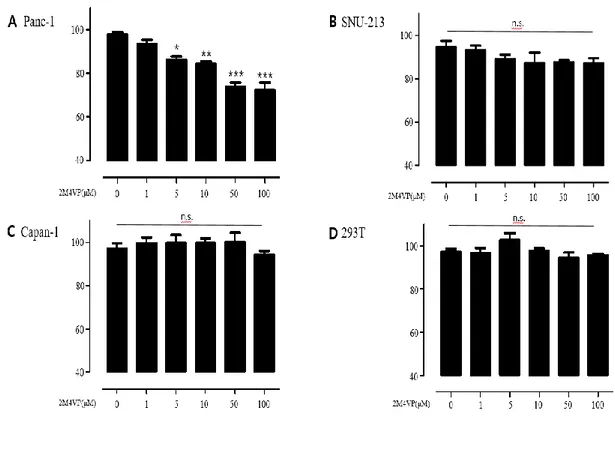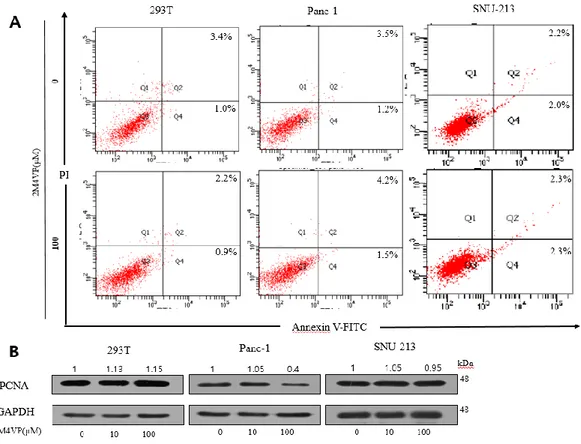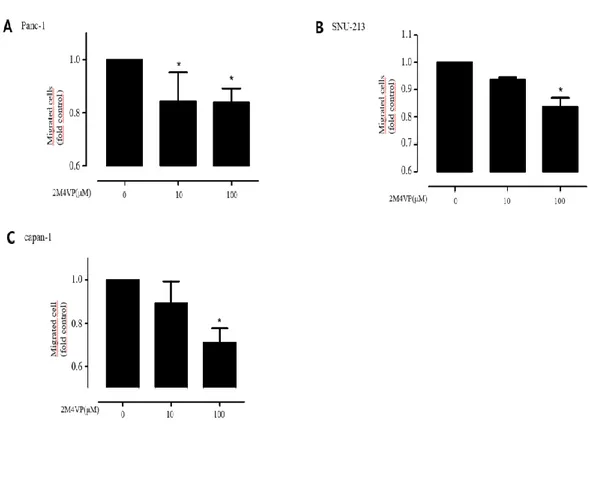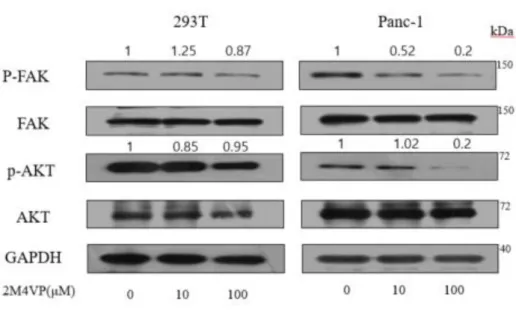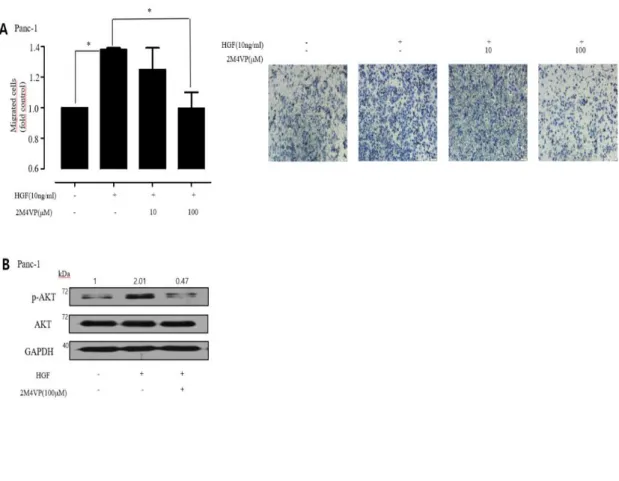저작자표시-비영리-변경금지 2.0 대한민국 이용자는 아래의 조건을 따르는 경우에 한하여 자유롭게 l 이 저작물을 복제, 배포, 전송, 전시, 공연 및 방송할 수 있습니다. 다음과 같은 조건을 따라야 합니다: l 귀하는, 이 저작물의 재이용이나 배포의 경우, 이 저작물에 적용된 이용허락조건 을 명확하게 나타내어야 합니다. l 저작권자로부터 별도의 허가를 받으면 이러한 조건들은 적용되지 않습니다. 저작권법에 따른 이용자의 권리는 위의 내용에 의하여 영향을 받지 않습니다. 이것은 이용허락규약(Legal Code)을 이해하기 쉽게 요약한 것입니다. Disclaimer 저작자표시. 귀하는 원저작자를 표시하여야 합니다. 비영리. 귀하는 이 저작물을 영리 목적으로 이용할 수 없습니다. 변경금지. 귀하는 이 저작물을 개작, 변형 또는 가공할 수 없습니다.
Master's Thesis
2 - Methoxy - 4-vinylphenol induced
attenuation of cell migration in pancreatic
cancer cells.
Da-Hye KIM
Department of Biotechnology
GRADUATE SCHOOL
JEJU NATIONAL UNIVERSITY
2 I Methoxy -4|vinylphenol = all 5L9±
^ll=01l^lq EO,= ¥*lliLLL.
jz|EE± ZJ 7fl ±
J± Ll al
o| =Ei± o|q+ ^i^Ti+fi =i±J2.i xp|=6T]+
20201± 12 Ja
7± [|@|q C>|q+ ^i^Tq+fi =i±Tg °J=i}T=T
xplfq]q+H q]¥+fl
2 - Methoxy - 4-vinylphenol -induced
attenuation of cell migration in pancreatic
cancer cells.
Da-Hye KIM
(Supervised by Professor Jae Hoon Kim)
A thesis submitted in partial fulfillment of the requirement For the degree of Master of Science
December, 2020
This thesis has been examined and approved.
Chairperson of the supervising committee
Professor Tatsya Unno, Ph.D., College of Applied Life Sciences, Jeju National University
So W1.. (Tin
Professor so mi Kin, Ph.D., College of Applied Life Sciences, Jeju National University
Professor Jae Hoon Kin, Ph.D., College of Applied Life Sciences. Jeju National University
Department of Biotechnology
GRADUATE SCHOOL JEJU NATIONAL UNIVERSITY
i
2 - Methoxy - 4-vinylphenol -induced attenuation of cell
migration in pancreatic cancer cells.
CONTENTS
CONTENTS... i
LIST OF FIGURES...ii
ABSTRACT...1
1. INTRODUCTION...2
2. MATERIALS AND METHODS...5
2.1. Cell culture and reagents…………..……….………...……….5
2.2. Cell viability assay………....….……….5
2.3. Flow cytometry analysis………...…...5
2.4. Cell migration assay………...…….……...6
2.5. Western blot assay ……….……….….……...…...…...6
2.6. Statistical analysis……….………....…………..…….6
3. RESULTS ……….………...…..7
3.1. Proliferation inhibition of 2M4VP in Panc-1 cells………….…...7
3.2. 2M4VP inhibits metastasis………...………...10
3.3. Panc-1 inhibits HGF-induced metastasis by 2M4VP…………...…...13
4. DISCUSSION...15
5. REFERENCES...17
ii
LIST OF FIGURES
Figure 1.The picture of buckwheat.
Figure 2. Structure of 2-Methoxy-4-vinylphenol (2M4VP).
Figure 3.2M4VP treatment on pancreatic cancer cells.
Figure 4. 2M4VP inhibited cell proliferation.
Figure 5. 2M4VP migration inhibition effect.
Figure 6. The expression and phosphorylation analysis of FAK and AKT in 293T and Pacn-1
cells.
1
ABSTRACT
Pancreatic cancer is the most dangerous cancer, because it is difficult to diagnose and moves easily to other organs. Also, no relevant therapeutics have been developed; so there is a need for research on the treatment agents of pancreatic cancer. 2-Methoxy-4-vinyl phenol (2M4VP) is a flavoring compound with properties such as cycle arrest and anti-inflammation. In this study, we confirmed 2M4VP anticancer effects on pancreatic cancer-cell lines, including Panc-1 and SNU-213cells. 2M4VP reduced the viability of Panc-1 cells by inhibiting the proliferation of cell nuclear antigen (PCNA) protein. 2M4VP also suppressed the migratory activity of Panc-1 and SNU-213 cells. In addition, we demonstrated that the treatment with 2M4VP effectively decreased the phosphorylation of Focal Adhesion Kinase (FAK) and AKT pathways. These results suggest that 2M4VP might be used as a pancreatic cancer treatment supplement.
2
1. INTRODUCTION
Pancreatic cancer has a poor prognosis and five-year survival rate of less than 5% 3). Pancreatic cancer is one of the top 5 causes of death from cancer in the western world. The main characteristics of pancreatic cancer are an early systemic metastasis and local tumor progression, and occur with 1to 2 years after surgery (2, 4–6). The unique migration activity of pancreatic cancer makes an early diagnosis and medication difficult, and increases the mortality rate of pancreatic cancer patients (7, 8). Resistance to currently available anticancer drugs also makes it more difficult to treat pancreatic cancer (9, 10). Therefore, new agents inhibiting migration activity of pancreatic cancer are required (7). In addition, a hepatocyte growth factor (HGF) that is a 90-kDa glycoprotein, secreted by mesenchymal cells has recently been noted for its role in pancreatic cancer and is known to be involved in poor prognosis. HGF was originally identified as a liver mitogen and fibroblast-derived epitheial motility factor, and is the only physiological ligand for the MET receprot tyrosine kinase. Phosphorylation of AKT was induced by HGF, and the phosphorylated AKT persisted even when E-cadherin was inhibited in pancreatic cancer cells (11–14). Therefore, it is necessary to study the substances that regulate the HGF pathway and metastasis in pancreatic cancer cells.
Buckwheat is a dicotyledonous plant common in East Asian countries (Figure 1). Buckwheat is high in protein, contains a number of amino acids. Buckwheat contains various functional substances such as rutin, isovitexin, quercetin, which have been reported to be effective in antioxidant, anti-inflammatory, and anti-cancer (15–19). In particular, buckwheat contains buckwheat flavor compounds, such as
3
2,5-dimethyl-4-hydroxy-3(2H)-furanone,(E-)-2,4-decadienal, and 2-Methoxy-4- vinylphenol (2M4VP) (16). Especially, 2M4VP is used as a fragrance and is found also in apples and peanuts (Figure 2). 2M4VP is known to stop the cell cycle induced by benzopyrene, a carcinogen, in NIH3T3 cells and to have anti-inflammatory effect by inhibiting MAPK activation induced by LPS (20, 21). In this study, we investigated the anticancer effects of 2M4VP in pancreatic cancer cell lines and found that it inhibits cell migration in pancreatic cancer cells.
4 Figure 1. The picture of buckwheat.
5 Figure 2. Structure of 2-Methoxy-4-vinylphenol.
O
H
O
CH
3
6
2. MATERIALS AND METHODS
2.1 Cell culture and reagents
We obtained a human embryonic kidney cells 293T, Panc-1, and SNU-213 human pancreatic cells from Korean Cell Line Bank (Seoul, Korea). The 293T and Panc-1 cells were maintained in DMEM supplemented with 10% fetal bovine serum (Gibco-BRL, Gaithersburg, MD, USA), 100 U/mL penicillin, 100 μg/ml
streptomycin (Invitrogen, Carlsbad, CA, USA), and 5% at 37℃. SNU-213 cells were maintained in RPMI-1640 supplemented with 10% fetal bovine serum (Gibco-BRL), 100 U/mL penicillin, 100 μg/ml streptomycin (Invitrogen), and 5% at 37℃. The 2M4VP and HGF were purchased Sigma-Aldrich (Sigma-Aldrich, St. Louis, MO, USA).
2.2 Cell viability assay
We measured cell viability using the WST-1(2-(4-iodophenyl)-3-(4-nitro phenyl)-5-(2,4-disulfophenyl)-2H-tetrazolium) solution (Boechringer Mann
heim, Mannheim , Germany). Cells were seeded 2.5× in 24-well plates. After cells were incubated for 24 h, we were treated with 2M4VP for 72 h at 37℃. Each well was added to a final concentration of 10% WST-1 solution after 15 min incubation at room temperature. The absorbance was measured at 450 nm using the microplate reader.
2.3 Flow cytometry analysis
For apoptosis analysis, Panc-1 and 293T cells were seeded in 6-well plates. After 24 h, they were treated with 2M4VP for 72 h. After collecting the cells, we incubated the cells with Annexin V-FITC and PI (FITC Annexin V apoptosis detection kit, BD pharmigen). The apoptotic cells were detected by flow cytometry (LSRFortessa, BD).
7 2.4 Cell migration assay
The filter was pre-coated 1 μg/μl fibronectin (Sigma-Aldrich, St. Louis, MO, USA), and then 500 μl RPMI was added to the lower chamber. The suspended cells were treated with 2M4VP in serum-free medium in the upper chambers. Panc-1 cells were incubated for 6 h at 37℃, and SNU-213 cells were incubated for 6 h at 37℃. Then these cells were fixed using 4% paraformaldehyde (Biosesang, Seongnam, Korea) and then stained using 0.1% crystal violet solution. Finally, we measured the absorbance of the solution eluted with 10% acetic acid at 560 nm using a microplate reader. HGF treatment was done for 30 min before the 2M4VP incubation for 6 h.
2.5 Western blot assay
Cells were lysed in M-PER lysis buffer (Thermo science, Bonn, Germany) containing protease inhibitor cocktail (Roche), 2mM sodium vanadate, 30mM sodium pyrophosphate, and 100mM sodium fluoride. After total protein quantification, proteins were separated by 10% SDS-PAGE (sodium dodecyl sulfate-polyacrylamide gel electrophoresis) and transferred to nitrocellulose membranes (Amersham Bioscience, Little Chalfont, Buckinghamshire, UK). Membranes were blocked with 5% skim milk in TBST. Primary antibodies, such as phospho-FAK (Tyr397), phospho AKT (Ser473), PCNA, and GAPDH (Cell signaling technology, USA), were diluted 1:1000 in TBST and incubated overnight at 4°C. Secondary antibodies (Merck Millipore, Germany) were diluted in TBST 1:4000 and incubated for 1h. The protein bands were detected by the ECL kit (Biosesang).
8 2.6. Statistical analysis
Error bars represent ±SEM. We did statistical analysis by one-way ANOVA, two-way ANOVA, and student’s t-test. p < 0.05 was considered to indicate significant differences.
9
3. RESULTS
3.1 Proliferation inhibition of 2-Methoxy-4-vinyl phenol in Panc-1 cells
We evaluated 2-Methoxy-4-vinyl phenol (2M4VP) anticancer effects in pancreatic cancer by means of a WST-1 assay in 2M4VP-treated Panc-1 and SNU-213 cells with various concentrations. Panc-1 cells showed a significant decrease in viability when treated with 2M4VP. On the other hand, SNU-213 cells and Capan-1 cells appeared no statistically significant difference. In control 293T cells, 100 μM 2M4VP treatment did not change viability, indicating that 2M4VP at 100 μM concentration was not cytotoxic (Figure 3). Cells were treated with 2M4VP and analyzed by flow cytometry to find out whether the reduction in viability of Panc-1 cells was due to apoptosis or to inhibition of proliferation. Figure 4A shows that apoptosis did not occur in 2M4VP-treated Panc-1 cells, SNU-213 cells and 293T cells. Next, to investigate cell proliferation, the expression of PCNA was examined. PCNA was downregulated in Panc-1 cells when treated with 2M4VP, but no significant changes were seen in SNU-213 and control cells (Figure 4B). These results show that 2M4VP inhibits proliferation in Panc-1 pancreatic cancer cells.
10
Figure 3. 2M4VP treatment on pancreatic cancer cells. WST-1 assay were performed after treatment with 2M4VP (0, 5, 10, 50, 100 μM) on Panc-1 (A), SNU-213 (B), Capan-1 (C) and 293T (D) cells. (p < 0.05; stars indicate a significant difference vs. 0, *p < 0.05, **p < 0.01, ***p < 0,001).
11
Figure 4. 2M4VP inhibited cell proliferation. (A) Flow cytometry analysis of Panc-1,
SNU-213, and 293T cells with or without 2M4VP treatment. (B) The expression of PCNA through Western blot after treating 2M4VP for 50 h in Panc-1, SNU-213, and 293T cells. The relative band intensities of PCNA/GAPDH was measured using Image J software
12
3.2 2-Methoxy-4-vinyl phenol inhibits metastasis by regulating p-FAK and p-AKT in Panc-1 and SNU-213 cells
To evaluate the anticancer effects of 2-methoxy-4-vinyl phenol (2M4VP), 2M4VP was incubated with Panc-1 and SNU-213 cells at 0, 10, and 100 μM for 6 h using a transwell assay. Panc-1 cell migration was reduced by about 15% after treatment for 6 hours by 10 μM 2M4VP (Figure 5A). In SNU-213 cells, 2M4VP inhibited the migration by about 9% at 10 μM 2M4VP and about 17% at 100 μM 2M4VP (Figure 5B). The Capan-1 cells were reduced by about 35% treatment for 12 hours by 100 μM 2M4VP (Figure 5C). These results suggest that 2M4VP inhibits the metastasis of pancreatic cancer cells and is more effective in Panc-1 than in SNU-213 and Capan-1. To identify a mechanism for inhibiting metastasis through protein phosphorylation, Panc-1 cells were treated with 2M4VP (0, 10, 100 μM) for 24 hours. The treatment reduced the phosphorylation levels of FAK (Tyr 397) and AKT (ser473) (Figure 6). However, the phosphorylation level of FAK and AKT did not change in 2M4VP-treated control cells.
13
Figure 5. 2M4VP migration inhibition effect. (A) Migration activities on Panc-1
cells after treatment of 2M4VP for 6 h. (B) Migration activities on SNU-213 cells after treatment of 2M4VP for 6 h. (C) Migration activities on Capan-1 cells after treatment of 2M4VP for 12 h.
14
Figure 6. The expression and phosphorylation analysis of FAK and AKT in 293T
and Pacn-1 cells. The relative band intensities of p-FAK/FAK and p-AKT/AKT were measured using Image J software.
15
3.3 Panc-1 inhibits hepatocyte growth factor-induced metastasis by 2M4VP.
Hepatocyte growth factor (HGF) is known to induce metastasis in various cancers, such as colorectal, colon, prostate, and pancreatic cancer. To find out whether 2-methoxy-4-vinyl phenol (2M4VP) inhibits the HGF-induced metastasis, pancreatic cancer cells were first treated with 2M4VP for 30min and then treated with HGF (10 ng / ml) for 30 min. As expected, treatment of Panc-1 cells with HGF(10 ng/ml) resulted in about a 40% increase in metastasis, but 2M4VP treatment inhibited the migration induced by HGF, maintaining the same level of metastasis as in untreated cells (Figure 7A). In addition, we found that the phosphorylation level of AKT increased with HGF treatment and decreased to untreated levels by pretreatment with 2M4VP (Figure 7B). These results suggest that 2M4VP reduces the phosphorylation level of HGF-induced AKT and inhibits metastasis in Panc-1 cells.
16
Figure 7.Effect of 2M4VP on HGF-induced migration in Panc-1 cells (A).
(B) Effect of 2M4VP on the expression and phosphorylation of AKT in HGF-treated Panc-1 cells. The relative band intensities of p-AKT/AKT was measured using Image J software. (p < 0.05; stars indicate a significant difference vs. 0, *p < 0.05).
17
4. DISCUSSION
2-methoxy-4-vinylpenol (2M4VP) is an aromatic compound that has an anti-inflammatory effect by inhibiting NO production and that inhibits cell-cycle activation induced by a carcinogen, benzopyrene (20, 21). However, there have been no studies on the specific relationship between 2M4VP and cancer cells. In this study, we found that 2-methoxy-4-vinyl phenol (2M4VP) has anticancer activity in inhibiting cell proliferation and metastasis in pancreatic cancer cells. Proliferating cell nuclear antigen (PCNA) is known to regulate the cell cycle and cell proliferation by tetramerization with cyclin and p21 (22). In our experiment, 2M4VP treatment reduced the expression of PCNA by above 50% in Panc-1 cells. It can be expected that 2M4VP inhibits Panc-1 cell proliferation by inhibiting PCNA expression. This result is similar to that of a previous report that matrine, a compound isolated from the legume, suppresses cell proliferation by inhibiting the expression of PCNA and its related genes(23).
FAK is a non-receptor tyrosine kinase that activates downstream signaling pathways, such as proto oncogene tyrosine-protein kinase Src (Src) and phosphatidylinositol-3-kinase (PI3K) /AKT (24). FAK has been reported to be overexpressed in malignant tumors and is known to play an important role in cell survival, proliferation, migration, and invasion(24–27). In previous studies, we have reported that flavonoids, such as quercetin and kaempferol, are effective in inhibiting pancreatic cancer metastasis by inhibiting FAK phosphorylation [6, 10] Similarly, 2M4VP inhibited metastasis through the FAK pathway, thereby reducing the phosphorylation level of FAK. The PI3K/AKT pathway is known to be activated when hepatocyte growth factor (HGF) binds to the receptor, which control the
18
invasion and metastasis of cancer cells (11, 12, 28). HGF-induced cell migration in Panc-1 cells was reduced dose-dependently following treatment with 2M4VP. The induced AKT phosphorylation was also decreased. In conclusion, 2M4VP inhibited proliferation and metastasis in Panc-1 and blocked HGF-mediated metastasis. This study predicts that 2M4VP can be used as a reagent to inhibit metastasis of pancreatic cancer.
19
6. REFERENCE
1 JP Neoptolemos, J A Dunn, D D Stocken, J Almond, K Link, H Beger, C Bassi, M Falconi, P Pederzoli, C Dervenis, L Fernandez-Cruz, F Lacaine, A Pap, D Spooner, D J Kerr, H Friess MWB: Adjuvant chemoradiotherapy and chemotherapy in resectable pancreatic cancer: A randomised controlled trial. Lancet 358: 1576– 1585, 2001. PMID: 11716884. DOI: 10.1016/s0140-6736(01)06651-x
2 Smeenk HG, Van Eijck CHJ, Hop WC, Erdmann J, Tran KCK, Debois M, Van Cutsem E, Van Dekken H, Klinkenbijl JH and Jeekel J: Long-term survival and metastatic pattern of pancreatic and periampullary cancer after adjuvant
chemoradiation or observation: Long-term results of EORTC trial 40891. Ann Surg 246: 734–740, 2007. PMID: 17968163. DOI: 10.1097/SLA.0b013e318156eef3 3 Lee J, Lee J, Kim M and Hoon J: Dietary approach to attenuate human pancreatic cancer growth and migration with innoxiousness. J Funct Foods 30: 303– 312, 2017. DOI: 10.1016/j.jff.2016.12.032
4 Keleg S, Büchler P, Ludwig R, Büchler MW and Friess H: Invasion and metastasis in pancreatic cancer. Mol Cancer 2: 1–7, 2003. PMID: 12605717. DOI: 10.1186/1476-4598-2-14
5 Dimagno EP, Reber HA and Tempero MA: AGA technical review on the epidemiology, diagnosis, and treatment of pancreatic ductal adenocarcinoma. Gastroenterology 117: 1464–1484, 1999. PMID: 10579989. DOI:
10.1016/s0016-5085(99)70298-2
6 Lee J and Kim JH: Kaempferol inhibits pancreatic cancer cell growth and migration through the blockade of EGFR-related pathway in vitro, 2016. PMID: 27175782. DOI: 10.1371/journal.pone.0155264
20
7 Lee J, Lee J, Kim SJ and Kim JH: Quercetin-3-O-glucoside suppresses pancreatic cancer cell migration induced by tumor-deteriorated growth factors in vitro. Oncol Rep 35: 2473–2479, 2016. PMID: 26820381. DOI:
10.3892/or.2016.4598
8 Bardeesy N and DePinho RA: Pancreatic cancer biology and genetics. Nat Rev Cancer 2: 897–909, 2002. PMID: 12459728. DOI: 10.1038/nrc949
9 Ono H, Basson MD and Ito H: PTK6 Promotes Cancer Migration and Invasion in Pancreatic Cancer Cells Dependent on ERK Signaling. 9: 1–7, 2014. PMID: 24788754. DOI: 10.1371/journal.pone.0096060
10 Lee J, Han S, Yun J and Kim JH: Quercetin 3-O-glucoside suppresses epidermal growth factor – induced migration by inhibiting EGFR signaling in pancreatic cancer cells., 2015. PMID: 26109002. DOI: 10.1007/s13277-015-3682-x 11 Pothula SP, Xu Z, Goldstein D, Biankin A V., Pirola RC, Wilson JS and Apte M V.: Hepatocyte growth factor inhibition: A novel therapeutic approach in pancreatic cancer. Br J Cancer 114: 269–280, 2016. PMID: 26766740. DOI: 10.1038/bjc.2015.478
12 Watanabe S, Kishimoto T and Yokosuka O: Hepatocyte growth factor inhibits anoikis of pancreatic carcinoma cells through phosphatidylinositol 3-kinase pathway. Pancreas 40: 608–614, 2011. PMID: 21499215. DOI:
10.1097/MPA.0b013e318214fa6c
13 Friess H, Büchler MW and Korc M: Coexpression of the c -met
Proto-oncogene and Hepatocyte Growth Factor in Human Pancreatic Cancer. Cancer Res 54: 5775–5778, 1994. PMID: 7954397.
21
14 Zhou W, Jubb AM, Lyle K, Xiao Q, Ong CC, Desai R, Fu L, Gnad F, Song Q, Haverty PM, Aust D, Grützmann R, Romero M, Totpal K, Neve RM, Yan Y, Forrest WF, Wang Y, Raja R, Pilarsky C, De Jesus-Acosta A, Belvin M, Friedman LS, Merchant M, Jaffee EM, Zheng L, Koeppen H and Hoeflich KP: PAK1 mediates pancreatic cancer cell migration and resistance to MET inhibition. J Pathol 234: 502– 513, 2014. PMID: 25074413. DOI: 10.1002/path.4412
15 Bai CZHI, Feng MALI, Hao XUL and Zhao ZHIJ: Anti-tumoral effects of a trypsin inhibitor derived from buckwheat in vitro and in vivo. 1777–1782, 2015. PMID: 25901645. DOI: 10.3892/mmr.2015.3649
16 Janeš D, Kantar D, Kreft S and Prosen H: Identification of buckwheat
( Fagopyrum esculentum Moench ) aroma compounds with GC – MS. 112: 120–124, 2009. DOI: 10.1016/j.foodchem.2008.05.048
17 Sun T and Ho C: Antioxidant activities of buckwheat extracts. 90: 743–749, 2005. DOI: 10.1016/j.foodchem.2004.04.035
18 Shii SI, Atsumura TK, Hiozuka CS, Oyauchi KO, Awasaki KK, Akigawa ST, Ukushima TF, Okuji YT, Inoshita MK, Hnishi MO, Awahara MK and Hba KO: Anti-Inflammatory Effect of Buckwheat Sprouts in Lipopolysaccharide-Activated Human Colon Cancer Cells and Mice. 72: 3148–3157, 2008. PMID: 19060399. DOI: 10.1271/bbb.80324
19 Al-snafi PAE and Medicine C: A review on Fagopyrum esculentum : A potential medicinal plant. 7: 21–32, 2017. PMID: 27104519. DOI:
10.3390/ijms17040589
20 Jeong JB and Jeong HJ: 2-Methoxy-4-vinylphenol can induce cell cycle arrest by blocking the hyper-phosphorylation of retinoblastoma protein in
22
benzo[a]pyrene-treated NIH3T3 cells. Biochem Biophys Res Commun 400: 752–757, 2010. PMID: 20816752. DOI: 10.1016/j.bbrc.2010.08.142
21 Jeong JB, Hong SC, Jeong HJ and Koo JS: Anti-inflammatory effect of 2-methoxy-4-vinylphenol via the suppression of NF-κB and MAPK activation, and acetylation of histone H3. Arch Pharm Res 34: 2109–2116, 2011. PMID: 22210037. DOI: 10.1007/s12272-011-1214-9
22 Wei H, Wang C and Chen L: Proliferating cell nuclear antigen, survivin, and CD34 expressions in pancreatic cancer and their correlation with hypoxia-inducible factor 1α. Pancreas 32: 159–163, 2006. PMID: 16552335. DOI:
10.1097/01.mpa.0000202961.71600.9b
23 Lu Z, Xiao Y, Liu X, Zhang Z, Xiao F and Bi Y: Matrine reduces the proliferation of A549 cells via the p53 / p21 / PCNA / eIF4E signaling pathway. 2415–2422, 2017. PMID: 28447756. DOI: 10.3892/mmr.2017.6331
24 Kanteti R, Mirzapoiazova T, Riehm JJ, Dhanasingh I, Mambetsariev B, Wang J, Kulkarni P, Kaushik G, Seshacharyulu P, Ponnusamy MP, Kindler HL, Nasser MW, Batra SK and Salgia R: Focal adhesion kinase a potential therapeutic target for pancreatic cancer and malignant pleural mesothelioma. Cancer Biol Ther 19: 316–327, 2018. PMID: 29303405. DOI: 10.1080/15384047.2017.1416937 25 Peng X and Guan J-L: Focal Adhesion Kinase: From In Vitro Studies to Functional Analyses In Vivo. Curr Protein Pept Sci 999: 1–16, 2011. PMID: 21190526.
26 Mitra SK, Hanson DA and Schlaepfer DD: Focal adhesion kinase: In
command and control of cell motility. Nat Rev Mol Cell Biol 6: 56–68, 2005. PMID: 15688067. DOI: 10.1038/nrm1549
23
27 Schaller MD: Cellular functions of FAK kinases : insight into molecular mechanisms and novel functions., 2010. PMID: 20332118. DOI: 10.1242/jcs.045112 28 Matsumoto K, Nakamural T and Kramersnll H: Hepatocyte Growth
FactodScatter Factor Induces Tyrosine Phosphorylation of Focal Adhesion Kinase Migration and Invasion by Oral Squamous Cell Carcinoma Cells *. 269, 1994. PMID: 7527397.
24
